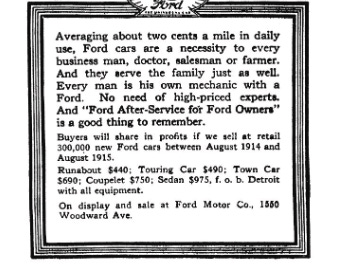Edited 10 September 2021
I am a Henry Ford-hater. I am an urbanist and perhaps no American carried a greater disdain for urban-living than Ford. Sometimes we can learn valuable lessons from people we hate and despise. So it is with historical figures. For example, Columbus was a brilliant navigator despite being a crank as an amateur cosmologer. He was fortunate that his incompetence in the latter did not undermine the former. He sailed across the Atlantic to land on small islands in the Caribbean, and was later able to return to the same spot. That is no mean skill given the technology available in the fifteenth and sixteenth centuries. Like Columbus, Ford was a crank and incompetent in some areas, but mastered some important skills through a lot of practice. For Columbus, his practice at navigation came to him as a sailor on expeditions west of Africa. Ford learned engineering by taking apart farm equipment and putting it back together.
Many Americans wrongly assume that Henry Ford invented the automobile. Instead, he designed an automobile affordable for working Americans. Yet, he was not even the first to design a low-cost automobile in the US. Ransom Olds designed his curved-dash roundabout before Ford. However, Ford and Olds both anticipated a future of the everyman’s automobile (early driving was extremely gendered) instead of expensive cruising cars for the wealthy. Ford, far from being unique in his prescience in marketing the automobile, at least avoided the path of luxury automobiles, which now represent a long list of forgotten brands.
Anticipating what to make was the first part of the problem. The second part of the problem was how to make this affordable automobile. It would need to be durable and powerful. America still lacked a network of paved roads, and most pavements that existed were poor compared to present-day standards. His car would need to endure the punishment of the treacherous roads and be able to power through deep ruts and quagmires. On the power side, many engineers designed more powerful engines. Yet the more powerful engines carried greater weight and required heavier frames to support them. Cars with more powerful engines did not add much if any extra speed due to the increased weight of the vehicle. Ford understood the speed problem as a power-to-weight ratio. So he was satisfied with his own moderately powerful engine. He focused on reducing the weight of his car in order to increase the power-to-weight ratio. This he accomplished by experimenting with different metals. He found a lightweight alloy (vanadium steel) that was very strong, which had been rejected by the US Navy for constructing ships. Ford found processes for stamping and shaping this metal, creating the lightweight solution for his car frames. Using only a moderately powerful engine, Ford produced a car with one of the highest power-to-weight ratios, as well as a car that could take persistent abuse on America’s poor roads.
The urbanist in me despises Henry Ford. He hated cities and he promoted a technology which resulted in degrading them. At the same time, this self-taught farm kid devised a business plan to profitably produce automobiles and led engineering solutions to produce an inexpensive, powerful, and durable vehicle. These accomplishments demonstrate intelligence, creativity, and persistence. Furthermore, Ford is a compelling figure because he was riding the wave of social trends, and understanding the person is helpful in understanding the era.




